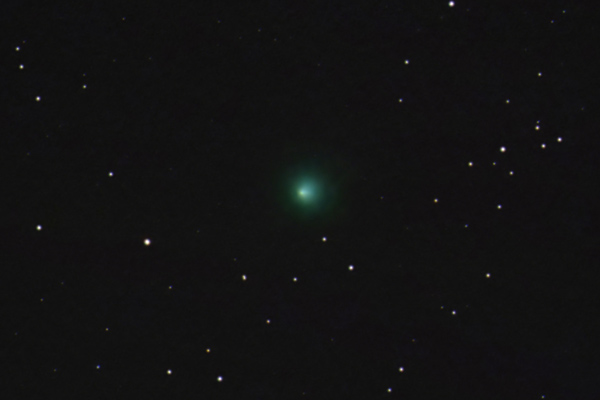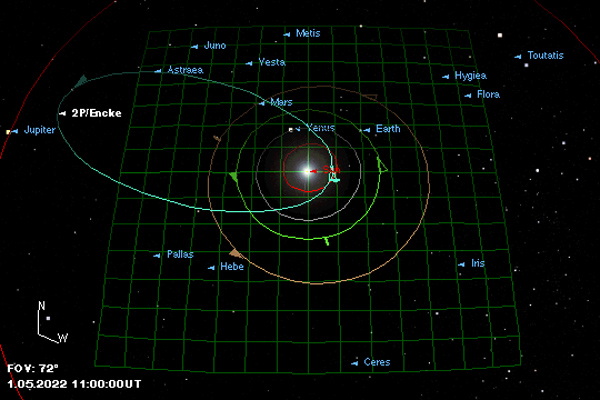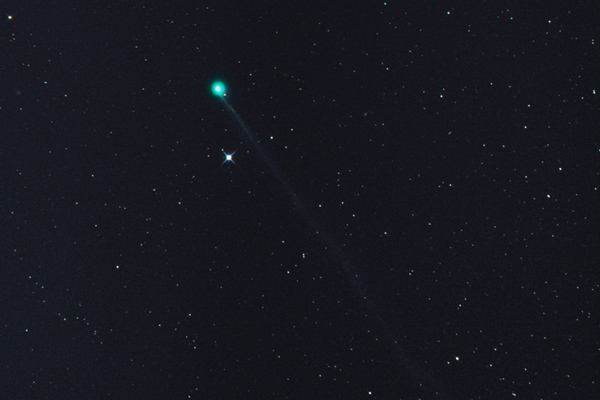Encke
Contents
 Comet Encke on October 2013 / cajunastro.com
Comet Encke on October 2013 / cajunastro.comAlso known as "old faithful", Encke was the second periodic comet in history who had a determined orbit, as a result Encke was given the name of the calculator and not the discoverer. Encke is a periodic comet with a very short run of only 3 years. It comes within Earths view (though not always visible to the naked eye) in such a short period because unlike most comets, Encke only goes as far out as Jupiter. The comet formed and spent most of its "youth" in either the Kuiper Belt or the Oort Cloud but somewhere along the line the comet became caught Jupiter's pull and remained within orbit between the sun and Jupiter ever since.
Discovery
Like Halley's comet, Encke's name came from the person who calculated its orbit, Johann Encke, and not by its discoverer. The first recorded discoverer of Encke's comet was actually Pierre Méchain in 1786 but it was not identified as a periodic comet until Encke computed its orbit in 1819. It was through recordings of sightings of the comet from Caroline Herschel in 1795, Jean-Louis Pons in 1818, and many other independent sightings that led Encke to the realization it was a periodic comet.
Orbit
 Orbit of Comet Encke / nasa.gov
Orbit of Comet Encke / nasa.govEncke orbits the sun at a low inclination of 11.76° every 3.3 years and is the shortest of the reasonably bright comets but second shortest of overall comets, 311P/Panstarrs beats it at 3.2 years. Its orbit, from time to time, brings it within 25,894,000 km (16,090,000 mi) which is relatively close and it has close approaches to Earth roughly every 33 years.
Encke is in a relatively stable orbit between the sun and Jupiter but believed to have originally formed in the Kuiper Belt. During its return towards the belt, Jupiter's gravitational pull prevented it from reaching its destination and it became locked in its current orbital path.
 Image of comet Encke was taken in Jauerling (lower Austria) / nasa.gov
Image of comet Encke was taken in Jauerling (lower Austria) / nasa.govEncke is becoming fainter with each pass due to the loss of material. As it does not return to the Kuiper Belt, the loss of material is not replenished in some way and so it is diminishing with time. Its highest magnitude on record was 3.5 in 1829.
During ancient times, however, it was very bright and the symbol of the Swastika may have come from ancient astronomers view of the comet. A silk comet atlas from the Han Dynasty topped by a comet, possibly Encke, had this symbol. At a direct approach of this comet, its jets would curve creating a swastika look.
Observations
 A Spitzer image of Encke and its debris trail in infrared light / caltech.edu
A Spitzer image of Encke and its debris trail in infrared light / caltech.eduEncke's elongated nucleus is about 4.8 km (2.98 miles) in diameter. It rotates at an estimated 15-hour intervals as it orbits around the sun. As it orbits it leaves a dust trail behind that scientist believe is the cause of the seasonal meteor showers that we experience in November and June, Taurids and Beta Taurids.
In 1908, the Tunguska Meteorite leveled 2,150 square km (830 square miles) of trees in Siberia. Encke may have been responsible for this. Scientists have concluded that the Tunguska Meteorite was, in fact, a broken off piece of Encke.
When describing the Tunguska event in 1908, it is often called an air burst explosion with the equivalency of a multi-megaton nuclear blast. Many discussions have been held at scientific and governmental agencies hypothesis what would occur if Tunguska or any object of its size were to have hit a populated area such as a city. This brought into question safeguards against such events as well as preparation plans for handling such events.
 Artist's impression of Tunguska event / deviantart.com
Artist's impression of Tunguska event / deviantart.comEncke has given us the unique opportunity to witness the orbital patterns of comets. One observation that has been noticed from watching Encke is that comets do not orbit at a constant. Their speed accelerates and decelerates periodically. Another observation is that their orbital path changes slightly, moving closer to Earth some runs and moving further from Earth in others, due to the gravitational pull of surrounding bodies. Jupiter is the biggest contributor of this with its high gravitational influence.
Encke was last seen on November 21, 2013, and is due to return on March 10, 2017. Visibility from our northern hemisphere expected but not without the aid of a telescope. It will brighten as it draws closer and will be within our southern hemisphere by the time it begins to move out of the inner solar system and out of Earths view again.
Video Gallery

-
 Comet Encke's tail ripped by the Sun
Comet Encke's tail ripped by the Sun
-
 Solar Hurricane Tears Off Tail of Comet Encke
Solar Hurricane Tears Off Tail of Comet Encke
-
 Taurids and meteorites: fragments from comet Encke
Taurids and meteorites: fragments from comet Encke